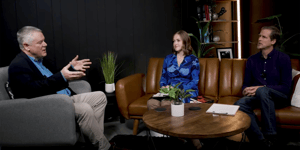In today’s episode, Dan and Catherine are joined by Dr. Daniel Toma. Dr. Toma has a doctorate in Behavioral Genetics and specializes in the convergence between faith and science. In this episode, he offers a fresh new perspective of looking at scientific creation through a liturgical lens, which he explores in his book, Vestige of Eden: Image of Eternity. He explores how one can interpret data through a Catholic worldview instead of the materialistic view of science that dominates much of contemporary scientific research.
Revealed Purpose in the Scientific World
Dr. Toma explains that during his early academic years, through reading the early Church fathers, he learned about how there is a natural knowledge of God that can be revealed through our experience. This natural knowledge can begin to take us from the lower things of life to a revealed understanding of the higher things. Through moving and contemplating higher things, we are able to form societies and participate in the purposes of the universe. Yet, all revealed meaning in the universe participates in a tripartite structure.
Scientism vs. Common Experience
A lot of the modern scientific language and analysis seems to be a few steps removed from common experience. In this way it can often feel like science is mechanistic and separated from the meaning we find in our lives. However, Dr. Toma explains that we begin to know things through our first contact with reality. By understanding the first principles of nature, we can begin to understand science in a meaningful way.
For instance, someone like a farmer would say that there is definitely meaning in nature. Likewise, we can look at the seasons changing year after year and observe that things always seem to be moving towards an end, even if we observe them passively. In nature, different things may happen with different drives, but they all come together like an orchestra to form the basic structures of the material world. There are universal laws and constant directionality in Biology.
How Creation Reflects the Liturgy
Dr. Toma explains that all of creation reflects the liturgy through three steps:
- Purgation
- Illumination
- Union
The Liturgy is structured so that one goes through a process of purgation by entering a new life with the Church; true meaning is illuminated through the consecration, and we enter into union with our creator through receiving the Eucharist.
The Church is not simply an institution but is the pinnacle of creation being drawn towards its creator. All of reality is a rich process, brimming with meaning. The world is participating in an ongoing journey of deification that permeates all of being. Even the material world reflects this process through plants and animals, which can lead us to contemplate God.
Take a Listen
This episode demonstrates that we should interpret science through the lens of Catholicism. Although much of contemporary science would have us believe that science can only be materialistic, Dr. Toma shows us that the material world comes alive with meaning when understood through the illuminating light of the liturgy. When adopting this worldview, we can begin to see that science points to our creator in virtually every way and the compatibility of faith and science becomes evermore so apparent.

